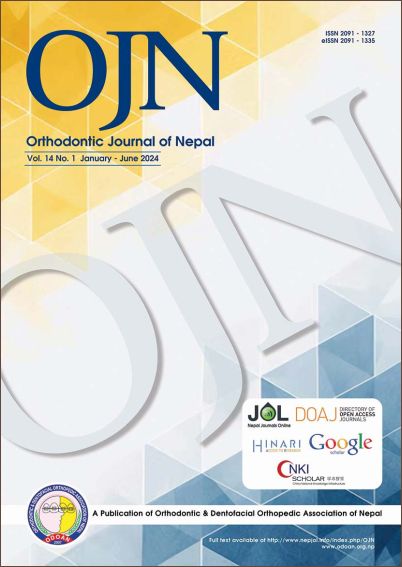Influence of Maxillary Canine Vertical Position on the Perception of Smile Esthetics among Orthodontists and Laypersons
DOI:
https://doi.org/10.3126/ojn.v14i1.60927Keywords:
Canine, Laypersons, Orthodontists, SmileAbstract
Background: Most patients seek orthodontic treatment to enhance the esthetics of their smile. Orthodontists must consider the influence of mini –esthetics on smile.
Objective: This study aimed to analyze the attractiveness of a frontal smile in a model with altered vertical position of the canine and to evaluate the difference between the esthetic perceptions of orthodontists and laypersons.
Materials and Methods: An adult female was selected for this study who was adjudged to have an ideal smile by the authors. The frontal posed smile photograph was digitally altered by adjusting the vertical positions of the maxillary canines above, below, or coincident with the incisal line in increments of 0.5 mm within a range of 1 mm of extrusion and intrusion. For assessment, a web-based survey was formed with six images. A scale was present underneath each image, graded from 0 to 10 (0: unattractive; 10: the most attractive). Images were rated by 98 participants (45 orthodontists and 53 laypersons). The chi-square test was used to compare the ratings between orthodontists and laypersons.
Result: Both orthodontists and laypersons scored 0-mm image as highest with ratings of 8.04 ± 1.33 and 8.24 ± 1.34 respectively and 1-mm extrusion image as lowest with ratings of 2.87 ± 2.31 and 5.23 ± 2.81 respectively. There was a statistically significant difference in the ratings of 1-mm and 0.5-mm canine extrusion images among orthodontists and laypersons.
Conclusion: Both orthodontists and laypersons rated the standard smiles (considered harmonious with respect to the smile line) and the smiles with 0.5 mm of intrusion as the most attractive. In general, both groups found smiles with 1 mm of extrusion and 1 mm of intrusion to be less attractive.
Downloads
Downloads
Published
How to Cite
Issue
Section
License
Copyright (c) 2024 Orthodontic & Dentofacial Orthopedic Association of Nepal

This work is licensed under a Creative Commons Attribution 4.0 International License.
Copyright © held by Orthodontic & Dentofacial Orthopedic Association of Nepal
- Copyright on any research article is transferred in full to the Orthodontic & Dentofacial Orthopedic Association of Nepal upon publication in the journal. The copyright transfer includes the right to reproduce and distribute the article in any form of reproduction (printing, electronic media or any other form).
- Articles in the Orthodontic Journal of Nepal are Open Access articles published under the Creative Commons CC BY License (https://creativecommons.org/licenses/by/4.0/)
- This license permits use, distribution and reproduction in any medium, provided the original work is properly cited.




